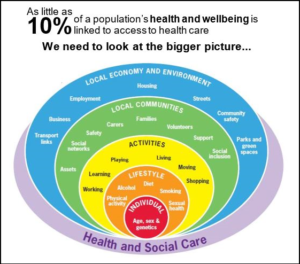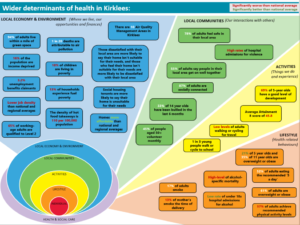 Wider Factors
Wider Factors
An Introduction to Wider Factors

A person’s opportunity for good health starts long before they need healthcare (1), and it is widely accepted that a population’s health is largely shaped by factors beyond access to healthcare (1, 2). Wider determinants (also known as the ‘social determinants of health) are a diverse range of social, economic, cultural, political and environmental factors which impact on people’s health.
These are the factors which shape the conditions in which people are born, grow, live, work and age, and in turn have a significant impact on their health outcomes throughout the lifecourse (from pre-natal and early years all the way through to end of life).
e.g.
- Children living in cold homes are more than twice as likely to suffer from respiratory problems (3)
- Young adults who are unemployed are more than twice as likely to suffer from mental ill health than those in work (4)
- People with the lowest life expectancy are three times more likely to have no qualifications compared with those with the highest life expectancy (5)
- It is three times more expensive to get the energy we need from healthy food than unhealthy food (6)
These circumstances are often shaped by the distribution of money, power and resources and closely linked to an individual’s socioeconomic status. We know that those living in poorer socioeconomic circumstances will, on average, have lower life expectancy and spend less years in good health. See inequalities section for more details.
These wider determinants can affect people in different ways, according to factors like age, gender, ethnicity, sexuality and disability.
These ‘causes of causes’ influence our behaviours – unhealthy behaviours are not usually the origin of poor health, but the end point of a long chain of causes and consequences in people’s lives.

References
1) National Institute for Health and Care Excellence, Health Inequalities and Population Health (2012).
2) McGovern L, Miller G, Hughes-Cromwick P. Health Policy Brief: The relative contribution of multiple determinants to health outcomes. Health Affairs. 21 August 2014 Available from: https://www.healthaffairs.org/do/10.1377/hpb20140821.404487/full/healthpolicybrief_123.pdf
3) Marmot Review Team (Geddes I, Bloomer E, Allen J, Goldblatt P). The health impacts of cold homes and fuel poverty. Friends of the Earth; 2011. Available from: https://www.instituteofhealthequity.org/resources-reports/the-health-impacts-of-cold-homes-and-fuel-poverty/the-health-impacts-of-cold-homes-and-fuel-poverty.pdf
4) UCL Institute of Education. Being on a zero-hours contract is bad for your health, new study reveals. 5 July 2017. Available from: https://www.ucl.ac.uk/ioe/news/2017/jul/being-zero-hours-contract-bad-your-health-new-study-reveals
5) Office for National Statistics. An overview of lifestyles and wider characteristics linked to Healthy Life Expectancy in England: June 2017. Available from: https://www.ons.gov.uk/peoplepopulationandcommunity/healthandsocialcare/healthinequalities/articles/healthrelatedlifestylesandwidercharacteristicsofpeoplelivinginareaswiththehighestorlowesthealthylife/june2017
6) Jones NRV et al. The growing price gap between more and less healthy foods: analysis of a novel longitudinal UK dataset. PLOS One. 2014;9(10):e109343. Available from: https://journals.plos.org/plosone/article?id=10.1371/journal.pone.0109343
Data Sources for ” wider determinants exploding rainbow”
| Indicator description | Source |
| % adults live within a mile of green space | Current Living in Kirklees (CLiK) adult population survey (2016), Kirklees Council Public Health Intelligence |
| % of population income deprived | Income deprivation, English Indices of Deprivation 2015 |
| % population claiming unemployment benefits | Job Seekers Allowance statistics (2018), Department for Work and Pensions |
| Job density | Office for National Statistics via NOMIS: https://www.nomisweb.co.uk/query/construct/summary.asp?mode=construct&version=0&dataset=57 |
| Working-age adults qualified to Level 2 | Current Living in Kirklees (CLiK) adult population survey (2016), Kirklees Council Public Health Intelligence |
| Deaths attributable to air pollution | DEFRA/Air Pollution and Climate Change Group Public Health England (2016), available via PHOF |
| Children living in poverty | Children (under 16) in Low Income Families, HM Revenue and Customs (Personal Tax Credits: Related Statistics – Child Poverty Statistics) (2016) |
| Households experiencing fuel poverty | Fuel Poverty Sub-Regional Statistics, Department for Business, Energy and Industrial strategy (2017) |
| Density of hot food takeaways | Numerator: PointX. Points of Interest (2014), Denominator: ONS mid-year estimates of population (2014) |
| Satisfaction with local area and suitability of housing | Current Living in Kirklees (CLiK) adult population survey (2016), Kirklees Council Public Health Intelligence |
| Social tenants and suitability of housing | Current Living in Kirklees (CLiK) adult population survey (2016), Kirklees Council Public Health Intelligence |
| Affordability of homes | House price to residence-based earnings ration (2018), Office for National Statistics |
| % adults feel safe in the local area | Current Living in Kirklees (CLiK) adult population survey (2016), Kirklees Council Public Health Intelligence |
| Hospital admission rates for violence | Calculated by Public Health England: Knowledge and Intelligence using data from the Health and Social Care Information Centre – Hospital Episode Statistics (HES) and Office for National Statistics (ONS) – Mid Year Population Estimates, available via fingertips: wider determinants |
| % adults who say people in their local area get on well together | Current Living in Kirklees (CLiK) adult population survey (2016), Kirklees Council Public Health Intelligence |
| % adults socially connected | Current Living in Kirklees (CLiK) adult population survey (2016), Kirklees Council Public Health Intelligence |
| % of 14 year-olds who have been bullied | Young People’s Survey (2018), Kirklees Council Public Health Intelligence |
| % of people aged 50+ who volunteer monthly | Current Living in Kirklees (CLiK) adult population survey (2016), Kirklees Council Public Health Intelligence |
| % of 5-year-olds with achieving Good Level of Development | Early Years Foundation Stage Profile (2017/18), Department for Education (DfE) |
| Average attainment 8 score | Average Attainment 8 score for all pupils in state-funded schools, based on local authority of pupil residence (2017/18), Department for Education (DfE) |
| Adults walking and cycling | Active Lives Survey, Sport England (2017), data available via Department for Transport Walking and Cycling statistics: https://www.gov.uk/government/collections/walking-and-cycling-statistics |
| Young people walking and cycling to school | Kirklees Council Public Health Intelligence, Young People’s Survey (2018) |
| 5-year-olds and 11-year-olds who are overweight/obese | National Child Measurement Programme, 2017/18 |
| Adults eating ‘5 a day’ | Active Lives Survey, Sport England (2017/18), available via PHOF |
| Adults overweight or obese | Active Lives Survey, Sport England (2017/18), available via PHOF |
| Adults achieving recommended physical activity levels | Active Lives Survey, Sport England (2017/18), available via PHOF |
| Levels of alcohol-specific mortality | Calculated by Public Health England: Risk Factors Intelligence (RFI) team from the Office for National Statistics (ONS) Annual Death Extract Public Health Mortality File and ONS Mid Year Population Estimates (2015-17 period), available via fingertips: Local Alcohol Profiles |
| Under-18s hospital admissions for alcohol | Calculated by Public Health England: Risk Factors Intelligence (RFI) team using data from NHS Digital – Hospital Episode Statistics (HES) and Office for National Statistics (ONS) – Mid Year Population Estimates (2015/16 – 17/18 period), available via fingertips: Local Alcohol Profiles |
| Adult smoking rates | Annual Population Survey (2017) |
| Mothers smoking at the time of delivery | CHFT & MYHT maternity data (2017/18) |
Date this section was last reviewed
July 2019, RC
